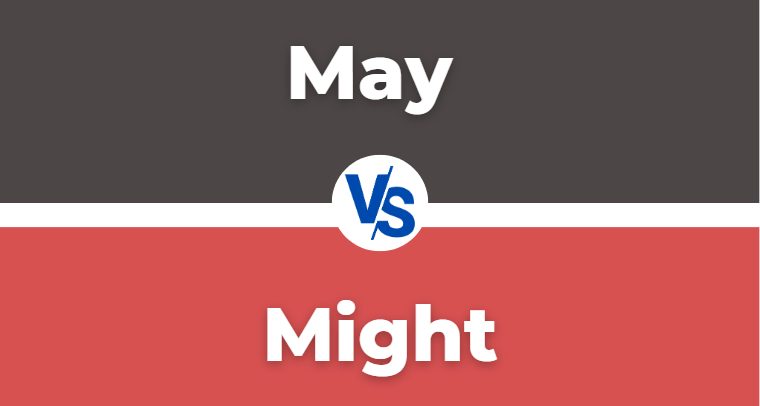May vs. Might: Use the correct word every time. Both words are modal verbs and are used to indicate possibility or permission and, probability. However, they are not interchangeable, and using them interchangeably can lead to confusion and miscommunication.
In this blog post, we will delve into the differences between may and might, and provide examples of when to use each one correctly. By the end of this article, you will have a better understanding of these two words and be able to use them more confidently in your writing and conversations. So, let’s get right into it!
“May” vs. “Might”: What’s the difference?
“May” and “might” are both modal auxiliary verbs that are used to express possibility or probability. While they are similar in meaning, there are some subtle differences between the two:
- Degree of Probability: “May” indicates a greater degree of possibility or likelihood than “might.” For example, “It may rain tomorrow” implies that there is a higher probability of rain than if you were to say “It might rain tomorrow.”
- Formality: “May” is generally considered more formal and polite than “might.” For example, if you were asking for permission to do something, you would typically use “may” instead of “might” (“May I leave the room?”).
- Tense: In the past tense, “may” becomes “might.” For example, “I may go to the store” becomes “I might have gone to the store” in the past tense.
- Politeness: “May” is generally considered more polite than “might.” For example, “May I borrow your pen?” is considered more polite than “Might I borrow your pen?”
- Hypothetical situations: “Might” is often used in hypothetical situations, while “may” is used for more concrete situations. For example, “If I had more time, I might study abroad” is a hypothetical situation, while “I may study abroad next semester” is a concrete situation.
In general, “may” is used to indicate a higher degree of probability or when a more formal tone is required. “Might” is used when the probability is lower or when the sentence is more informal. However, the distinction between the two can be subtle and the choice between them can be a matter of personal preference or context.
Using “May” in a Sentence
Here are a few examples of how to use “may” in a sentence:
- May I borrow your pen for a moment?
- She may come to the party later if she finishes her work on time.
- May the best team win the game tonight!
- The doctor said that I may need to take antibiotics for my infection.
- It’s possible that it may rain tomorrow, so bring an umbrella just in case.
Using “Might” in a Sentence
Here are some examples of sentences using the word “might”:
- I might go to the gym after work today.
- He said he might be a little late for the meeting.
- She’s not sure if she can make it, but she might come to the party.
- If the weather clears up, we might have a picnic this weekend.
- I might consider taking that job offer if the salary is good.
Common Misconceptions About May and Might
May and might are both modal verbs that are often used to express possibility or permission in English. However, there are some common misconceptions about how these two verbs are used. Here are a few of them:
- May and might are interchangeable: While both verbs can be used to express possibility, there is a slight difference in their meaning. May is more likely to be used when there is a higher degree of possibility, while might is used when the possibility is more uncertain. For example, “I may go to the party” implies a higher likelihood than “I might go to the party.”
Recognizing the Difference Between May and Might
In general, “may” is used to indicate a possibility that is more likely or more certain, while “might” is used to indicate a possibility that is less likely or less certain.
For example, consider the following sentences:
- “I may go to the store later.” (This suggests that it is more likely that the speaker will go to the store.)
- “I might go to the store later.” (This suggests that it is less likely that the speaker will go to the store.)
Another way to think about it is that “may” implies permission or allowance, while “might” implies uncertainty or doubt. For example:
- “You may leave the party early if you want.” (This implies that the person has permission to leave early.)
- “You might want to bring an umbrella in case it rains.” (This implies that there is some uncertainty about whether or not it will rain.)
In summary, “may” is generally used to indicate a greater likelihood or certainty, while “might” is used to indicate a lesser likelihood or uncertainty. However, in practice, the distinction between the two is often subtle and they can be used interchangeably in many cases.
Conclusion
In conclusion, understanding the difference between may and might is essential for clear communication. While both words indicate possibility or permission, they are not interchangeable, and using them interchangeably can lead to confusion. May is used to indicating a higher probability or a more definite possibility, while might is used to indicate a lower probability or a more uncertain possibility. By keeping these differences in mind and using each word appropriately in your writing and conversations, you can avoid misunderstandings and communicate more effectively. So, next time when you’re in doubt, remember this article and use may or might appropriately based on the context.
